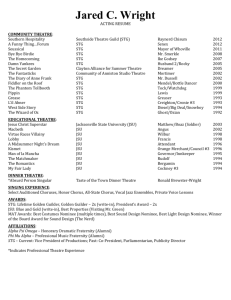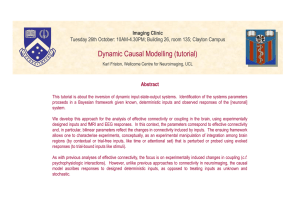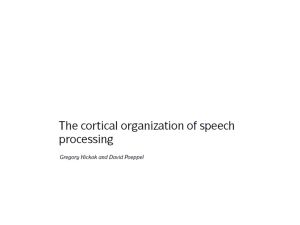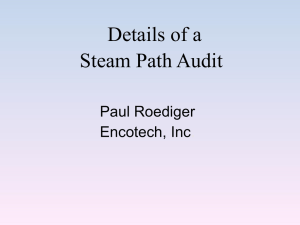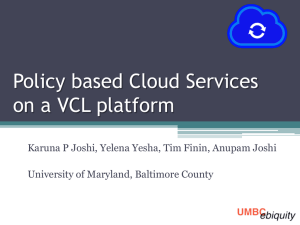Science and Technology
advertisement
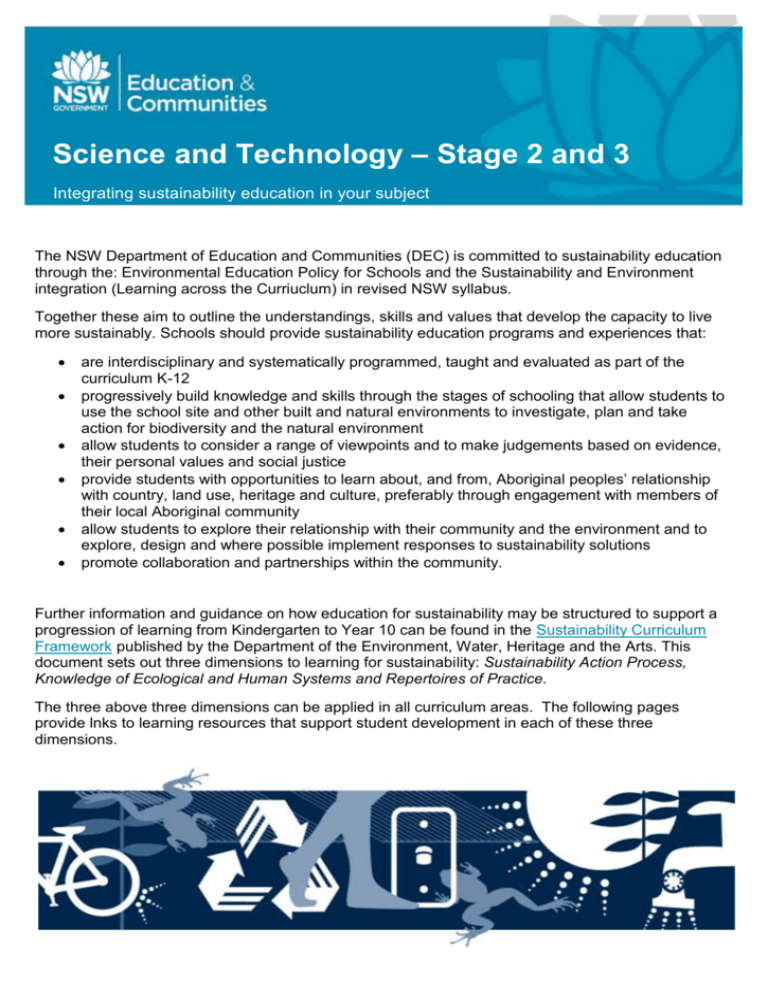
Science and Technology – Stage 2 and 3 Integrating sustainability education in your subject The NSW Department of Education and Communities (DEC) is committed to sustainability education through the: Environmental Education Policy for Schools and the Sustainability and Environment integration (Learning across the Curriuclum) in revised NSW syllabus. Together these aim to outline the understandings, skills and values that develop the capacity to live more sustainably. Schools should provide sustainability education programs and experiences that: are interdisciplinary and systematically programmed, taught and evaluated as part of the curriculum K-12 progressively build knowledge and skills through the stages of schooling that allow students to use the school site and other built and natural environments to investigate, plan and take action for biodiversity and the natural environment allow students to consider a range of viewpoints and to make judgements based on evidence, their personal values and social justice provide students with opportunities to learn about, and from, Aboriginal peoples’ relationship with country, land use, heritage and culture, preferably through engagement with members of their local Aboriginal community allow students to explore their relationship with their community and the environment and to explore, design and where possible implement responses to sustainability solutions promote collaboration and partnerships within the community. Further information and guidance on how education for sustainability may be structured to support a progression of learning from Kindergarten to Year 10 can be found in the Sustainability Curriculum Framework published by the Department of the Environment, Water, Heritage and the Arts. This document sets out three dimensions to learning for sustainability: Sustainability Action Process, Knowledge of Ecological and Human Systems and Repertoires of Practice. The three above three dimensions can be applied in all curriculum areas. The following pages provide lnks to learning resources that support student development in each of these three dimensions. Document title Science and Technology, Stage 2 and 3 Sustainability Curriculum Framework NSW DET Sustainability Education Policy allow students to experience, value and take action to protect biodiversity and the natural environment allow students to use the school site, other built environments and their local area to investigate, plan and take action to improve sustainability promote collaboration and partnerships within the community Knowledge of Ecological and Human are systematically programmed, taught and evaluated as part of the curriculum K-12 Systems are interdisciplinary; applying, connecting and progressively building knowledge and skills from across learning areas and through the stages of schooling provide students with opportunities to learn about, and from, Aboriginal peoples’ relationship with country, land use, heritage and culture, preferably through engagement with members of their local Aboriginal community Repertoires of Practice allow students to consider a range of viewpoints and to make judgements based on evidence, their personal values and social justice allow students to explore their relationship with the environment and to explore, design and where possible implement responses to sustainability challenges for both natural and built environments include different spatial scales (local to global, home to community). Stage 2 unit of work Material World Properties of natural and made materials. Using, conserving, renewing. Stage 2 & 3 unit of work Biodiversity To develop students’ understanding of biodiversity and its decline Sustainability Action Process 2 © State of New South Wales through the NSW Department of Education and Communities, 2011 Document title Science & Technology Sustainability Action Process Skills Outcomes Students will 1. Making the case for change Stg 2. Make accurate observations and describe these observations, or record them as diagrams, tables of data and graphs. Stg 2. State the issue or area to be investigated. Stg 2. Propose explanations using simple observations. Stg 2. Make a prediction based on data collected by themselves or others. Stg 2. Devise ways of checking or testing predictions. Stg 2. Describe needs and wants of people in relation to design activities. Stg 2. Use graphics, models and written data to record the exploration of different ideas for design proposals and to assist making. Stg 3. Make detailed observations using appropriate technologies. Stg 3. Use investigation techniques to identify opportunities for design activities. 2. Defining the scope Stg 2. Suggest modifications to design proposals to improve the original design. Stg 2. Use basic construction tools, materials and computerised data bases to refine observations. Stg 3. Discuss the factors that might affect an investigation. Learning for Sustainability Investigating: The Science Process Investigating Scientifically Living Greener Conduct an Energy Snapshot Energy Use calculator Promoting Energy Efficiency Power Saving Tips Studio E Be a Water Detective Conducting a Water Audit Playground Planting Sustainability Gardens, Grow an Idea The Virtual Garden Designing: The Technology Process Energy Rating Studio E 3 © State of New South Wales through the NSW Department of Education and Communities, 2011 Document title 3. Developing the proposal 4. Implementing the proposal 5. Evaluating and reflecting Stg 3. Identify data which support a particular prediction. Stg 3. Devise a test that will support or disprove a prediction. Stg 2. Organise systems for small scale mass production. Stg 2. Recognise the appropriate use of tools, equipment, hardware and software. Stg 3. Modify and apply their understanding in the light of their investigation. Stg 3. Select, reject or modify as appropriate the elements of design to evaluate the procedures and outcomes of a design task. Stg 3. Develop a design proposal by selecting and refining ideas and justifying choices. Stg 3. Produce a model, prototype, product or procedure to meet a specific design brief. Stg 3. Select appropriate tools, hardware, materials, equipment or software on the basis of their specific function and in order to gather information. Stg 3. Use appropriate equipment and tools to carry out a particular task, and understand the technology involved to record and present ideas. Stg 3. Use resources with consideration for the environment and adopt procedures which minimise waste. Stg 2. Evaluate materials and processes used. Stg 2. Report on the social and environmental Be Inspired Studio E Studio E Studio E 4 © State of New South Wales through the NSW Department of Education and Communities, 2011 Document title costs and benefits of familiar technology. Stg 3. Devise fair tests. Stg 3. Test, or propose ways of testing, the extent to which a product satisfies the design intentions. Stg 3. Record the economic, moral, social and environmental consequences of advances in technology Knowledge of Ecological and Knowledge and Understanding Outcomes Students will know and understand Human Systems Living cycles Stg 2. Plants and animals live in environments that supply their needs. Stg 2. Change occurs throughout the lifetime of living things. Stg 2. Living things depend on other living things to survive. Stg 3. Living things show variation within a species. Stg 3. The activities of people can change the balance of nature. Stg 3. Groups of living things have changed over long periods of time. Ecosystems and local environments Stg 2. Plants and animals live in environments that supply their needs. Stg 2. Change occurs throughout the lifetime of living things. Stg 2. Living things depend on other living things to survive. Stg 3. Living things show variation within a Learning for Sustainability Part of a Pattern Plants in Action Marvellous Micro-organisms Mini-Beasts Investigating Plants Insects Life Cycles Life Cycles - Whales Life Cycles - Birds Life Cycles - Crocodiles Life Cycles – Gum Trees Life Cycles - Butterflies Life Cycles - Flowers Surviving in Habitats The Living Land Backyard Biodiversity Environmental Activities Australian Plants and Animals Birds in Backyards Garden Detectives 5 © State of New South Wales through the NSW Department of Education and Communities, 2011 Document title species. Stg 3. The activities of people can change the balance of nature. Stg 3. Groups of living things have changed over long periods of time. Evolution of life Stg 3. Living things show variation within a species Stg 3. Groups of living things have changed over long periods of time. Change in living systems Stg 2. Change occurs throughout the lifetime of living things. Stg 3. Living things show variation within a species. Stg 3. The activities of people can change the balance of nature. Stg 3. Groups of living things have changed over long periods of time. Stg 3. There are many physical phenomena which change the environment. Stg 3. Environments on Earth have been affected by technology. Stg 2. Sounds are produced by vibrating objects and can travel through materials. Weather and climate Solar system and energy Food Chains - Deserts Food Chains - Wetlands Food Chains - Forests Habitats Interdependence Living Things Studying Habitats Ecosystems On Show Marine Parks Make Your Own Fossils DIY Fossils An Ancient Land A Change For The Better Animal Search Minerals and Fossils What on Earth? Biology Activities Royal Botanic Gardens Human Activity Earth and Space Weather in my World Climate Change Australian Museum – Climate Change Carbon Kids Space and Astronomy Activities Make a Solar BBQ 6 © State of New South Wales through the NSW Department of Education and Communities, 2011 Document title Stg 3. There are various forms of energy. Stg 3. A complete circuit is needed for an electrical device to work. Stg 3.The sun is the source of most of the energy on the Earth. Stg 3. Light can pass through some materials and not others, and when it does not shadows form. Stg 3. There are various parts to the physical environment, eg stars, planets, earth, air and water. Water Stg 3. There are various parts to the physical environment, eg stars, planets, earth, air and water. Social systems and subsystems Stg 2. People create specialised environments to meet specific needs. Stg 3. People try to control the conditions in the environments they build. Stg 3. People live in communities and build It’s Electrifying Energy Change Energy and Beyond-Spinning in Space Energy and Change-Smooth Moves Light Fantastic Light Investigation Sounds Great Magnetism Out in Space Switched On Light Up My Life Electric Kids Energy Kidz BBC Science The Science Zone Electricity Circuits Solar Energy Energy Quest Design a Solar Oven Lunar Cycles: Earth Glow Water Works The Magic of Water Murray River Marine Parks Human Activity Earth Alert Land use 7 © State of New South Wales through the NSW Department of Education and Communities, 2011 Document title Methods of assessing ecological sustainability Processes of historical change Civics and citizenship Ownership and property rights Economic systems and costs Materials and production environments to service their common needs. Stg 2. Computers are machines that store and process information. Stg 2. People use different technologies to organise and communicate information in different ways. Stg 3. Information can be represented in a number of different forms, including graphics, sounds and texts. Stg 3. Technologies continually offer new ways of creating and sending messages. Stg 2. Production technologies have changed over time. Stg 3. The activities of people can change the balance of nature. Stg 3. People try to control the conditions in the environments they build. Stg 3. The activities of people can change the balance of nature. Stg 3. There are environmental consequences of production and consumption. Stg 2. Structures are built from natural and processed materials and components. Stg 2. Materials and resources are used to Keep in Touch Moving Pictures Sailing, Sinking, Soaring Technology & Invention Documenting Design 3D Kit Maker Experiments In A Plant Research Laboratory Old Bernies Farm Renewable Energy Technology and the Environment Frog Pond Habitat Aboriginal Technology Technology and Culture Energy and Climate Change International Year of Biodiversity What’s It Made Of? Package it Better Material World 8 © State of New South Wales through the NSW Department of Education and Communities, 2011 Document title Built environment produce goods and commodities. Stg 2. Manufacturing processes convert raw materials into useful products. Stg 2. Materials are joined, formed, shaped and finished. Stg 2. Most natural resources are limited and so need to be used wisely. Stg 2. There are benefits and problems associated with human changes to the physical environment. Stg 2. Most materials come from the Earth and its surroundings. Stg 3. There are environmental consequences of production and consumption. Stg 3. Systems are designed to provide particular services. Stg 3. Systems are used to deliver and distribute goods. Stg 2. People create specialised environments to meet specific needs. Stg 2. Structures are built from natural and processed materials and components. Stg 2. Environments are sometimes modified to fulfil new and different requirements. Stg 3. People try to control the conditions in the environments they build. Stg 3. People live in communities and build environments to service their common needs. Stg 3. Both aesthetic and functional factors need Change Detectives Material World Matter & Motion Your Rubbish Pile Solar Energy Mystery Substances – Emergency Case Mystery Substances – Pure and Mixed Mystery Substances – Pure Substances Product Design Resistant Materials The Virtual Garden Australian Conservation Foundation: Consumption Atlas Designing and Making a Model Shelter Designing and making a Model Tower Indoor, Outdoor Waterwise, House & Garden Energy Efficient Houses - Design Energy Efficient Housing – Build for Value Energy Efficient Houses - Performance Architecture and Children My Neighbourhood Design A Room The Best Place to Live Design a Garden 9 © State of New South Wales through the NSW Department of Education and Communities, 2011 Document title to be considered when people make changes to their environments. Stg 3. Systems are used to deliver and distribute goods. Transport Agriculture and food Repertoires of Practice World viewing Systems thinking Values and attitudes Outcomes Students will Stg 2. Demonstrate confidence in themselves and willingness to make decisions, be honest and open in their dealings with others. Stg 2. Have a positive view of themselves and their capabilities. Stg 2. Show responsiveness to ideas. Stg 2. Be curious about and appreciate the natural and made environment. Stg 3. Demonstrate confidence in themselves and willingness to make decisions and to take responsible actions. Stg 3. Have a positive view of themselves and their capabilities. Stg 3. Exhibit self-direction in their own learning. Stg 3. Respect different viewpoints and ways of living. Stg 3. Be curious about and appreciate the natural and made environment. Stg 2. Persevere with activities to their completion. Stg 2. Show informed commitment to improving the quality of the local environment. Stg 3. Initiate and persevere with activities to Energy-Efficient House: Explore Design Out & About On the Move Eating Out Food For The Tucker Box Learning for Sustainability 10 © State of New South Wales through the NSW Department of Education and Communities, 2011 Document title Futures and design thinking Other Resources their completion. Stg 3. Respect the rights and property of others. Stg 3. Show a commitment to fair treatment for all. Stg 3. Develop rational and creative thinking. Stg 3. Gain satisfaction in their efforts to investigate, to design and make, and to use technology. Stg 2. Gain satisfaction in their efforts to investigate, to design and make, and to use technology. Stg 3. Show flexibility and responsiveness to ideas and evidence. Stg 3. Show informed commitment to improving the quality of society and the environment. Teaching Science & Technology Stage 2, a focus on literacy & numeracy Teaching Science & Technology Stage 3, a focus on literacy & numeracy 11 © State of New South Wales through the NSW Department of Education and Communities, 2011 Document title Material World (Stage 2) Content focus: Material World Built Environments Products and Services Earth and its Surroundings Outcomes - Knowledge and Understanding Students will know and understand that: • structures are built from natural and processed materials and • components • materials & resources are used to produce goods and • commodities • manufacturing processes convert materials into useful products • materials are joined, formed, shaped and finished • natural resources are limited and so need to be used wisely • there are benefits and problems associated with human changes to the • physical environment • most materials come from the Earth and its surroundings. • Students will: • recognise that the results of investigations can lead to more questions • show that designing and making can lead to the need for • investigations • recognise that designs are constrained by time, skills, tools and • materials • identify the forms & components used in the production of a design Skills Students will: • state the issue or area to be investigated • propose explanations using simple observations • make a prediction based on data collected by themselves or others • describe needs and wants of people in relation to design activities • suggest modifications to design proposals to improve the original design • organise systems for small–scale mass production • recognise the appropriate use of tools, equipment, hardware and software • use basic construction tools, materials and computerised databases to refine observations. 12 © State of New South Wales through the NSW Department of Education and Communities, 2011 Document title • • • • • relate planning and evaluating to each stage of designing and making relate the particular properties of materials to end uses explain that technology can be used to help people learn justify the selection of processes, tools, equipment, materials, products and software to meet the requirements of the task. Values and Attitudes Students will: • demonstrate confidence in themselves and willingness to make • decisions • have a positive view of themselves and their capabilities • show responsiveness to ideas • persevere with activities to their completion • respect the rights and property of others • work cooperatively in groups • show informed commitment to improving the quality of their local • environment • be curious about and appreciate the natural and made • environment • gain satisfaction in their efforts to investigate, to design and make and to use technology. Assessment Listed below are selected examples of strategies that may be used in assessing this unit of work. • Discuss with students times when designing and making has resulted in the need to investigate. • Arrange interviews between students and members of the targeted audience in order to assess how well students have identified their specified need. • Have groups of students discuss and evaluate each phase of the mass production activity. • Have students construct a flow chart of the production process. • 13 © State of New South Wales through the NSW Department of Education and Communities, 2011 Document title • • • • • • • • • • • Links with other Key Learning Areas English Using talking and writing to cooperatively plan, select, consult and make decisions in designing and making their product, recording ideas. Exploring the language use targeted for certain groups, e.g. teenage slang. Mathematics Comparing characteristics of objects. Comparing length, mass, volume of objects. Human Society and its Environment Investigating how people use the environment to satisfy their physical and social needs. Personal Development, Health and Physical Education Using exploration of human needs and wants, and how they change, to lead into science and technology activities. Creative and Practical Arts Exploring ideas of texture and colour. Designing paper with characteristics to meet particular needs. Task Design and make a structure or device to perform a given task. [G] Activities Negotiate the design task. Clarify the requirements of the design. [TS18] Allot students into teams to develop their own structure. Specifications should include such things as being able: • to support a particular weight • to transport material • to protect something • to keep something dry. Consider availability of resources and range of materials, e.g. cupboard, split pins, cotton wool, masking tape. [TS19] Make the devices. Present and demonstrate the devices and evaluate according to the requirements of the design brief. Task Investigate the properties of materials. [G] 14 © State of New South Wales through the NSW Department of Education and Communities, 2011 Document title Activities Obtain a selection of materials, eg paper, cardboard, straws, plastics, wood, cotton wool, rubber, glass, ceramics, cork, pumice, metals, fibreglass, plasticine. [TS26] Classify the materials according to several different properties, eg ability to float, comparative mass, colour, attraction to magnets, transparency, flexibility, conducting heat/electricity. List suitability for particular tasks, eg for writing on, insulation, absorbing shock, roofing, allowing light to pass through, playing with. Explore how one or more of the properties may be changed, eg concerting a sheet of paper to increase its strength, heat wood to cause it to burn and char, heating metal may cause a colour change. [TS19] Identify materials used at other times and other places to perform a particular task, eg axe made of stone, fish hook made of bone. Suggest why these particular materials were chosen. Examine new materials which have replaced conventional materials, eg ceramic instead of amalgam tooth fillings, kevlar for canvas sails. [TS14] Discuss which system of classification is most useful. Task Investigate materials that can be recycled, renewed and conserved. [I] Activities Examine current waste disposal in the school. (If a recycling system already exists, evaluate its function.) Trace where waste products go. Measure the amount of rubbish thrown away in a day, a week. Evaluate the effects of this on the school and wider community. [TS17] Identify materials that can be recycled, e.g. food scraps, paper, plastic containers, glass, aluminium cans. Separate materials that can be usefully reused within the school, e.g. yoghurt pots. Organise recyclable materials into those to be recycled at school, e.g. food scraps made into compost, and materials that can be sent to a recycling service, e.g. paper, glass. Identify how materials used at home and school could be conserved. [I] Record for a period of two weeks how they conserved or wasted materials at home. [TS16] Design a chart to show the family ways in which common household materials can be conserved. Classify materials as renewable/non-renewable/recyclable. Task Design and make and organise a system to mass produce a product using changes of state. [W] Activities Suggest materials which can be moulded, e.g. plaster of Paris, chocolate, water/ice, jelly, wax. [TS6] Select product to be made, considering available moulds, preferences of the class group or other market. Consider costs involved 15 © State of New South Wales through the NSW Department of Education and Communities, 2011 Document title and price that needs to be charged. Publicise the product’s availability. Identify steps of the process involved, e.g. mixing ingredients, melting, filling moulds, cooling. Organise a suitable workspace, ensuring production needs are provided for, e.g. power points, access to refrigerator. Collect materials and equipment, including moulds. Allot roles for individuals. Ensure the production line works effectively. Make a prototype and evaluate materials, space and responsibilities. Effect any modifications, as required. [TS24] Trial the production of larger numbers. Make the product and distribute to purchasers. Evaluate the whole procedure. Task Investigate change of state from solid to liquid. [W] Activities Discuss the properties of solids and liquids. Compare the properties of several materials. List materials which are liquid at room temperature, eg water, ice cream, orange juice, or solid at room temperature, eg butter, chocolate, candle wax, toffee. [TS 6] Discuss materials which can be changed from liquids to solids and solids to liquids, eg water, chocolate, solid cooking oil, candle wax. Propose explanations as to how solids are changed to liquid/liquids changed to solid. Gather materials and test. Devise a method to demonstrate the changes, eg melt chocolate in sun, resolidify in refrigerator. Discover the temperature at which the materials will melt/solidify. (Extreme caution is needed when handling hot liquids.) Consider the effect on people if the Earth warmed several degrees and a lot of the ice on the poles melted. [TS11] 16 © State of New South Wales through the NSW Department of Education and Communities, 2011 Document title Biodiversity (Stage 2 & 3) Purpose and focus The purpose of this unit is to develop students’ understanding of biodiversity and its decline. Appreciate why biodiversity is important and how people can help reduce threats that impact on living organisms. The unit is structured using a series of input sessions and activities to build up the students’ knowledge and understanding of biodiversity. It also includes, a series of research activities and games and an audit of local plants as part of an investigation. The final task is four group design and make tasks which provide an opportunity for students to demonstrate their learning. Notes The unit was compiled for a small school, in a rural setting, to meet outcomes of a multi-stage class. There is significant background knowledge that is introduced during this unit, and builds on knowledge and understanding developed through activities associated with the specific environment of Burrumbuttock PS. This unit takes approximately 10 weeks. Tasks Tasks 1-5 To investigate plant and animal biodiversity. Observing and exploring (asks questions, pose problems, find out what is currently known) • Read/research environmental issues that have strong links to biodiversity, eg food chain, pollution, land degradation • Mind map biodiversity concept including threats. • Students collect pond animals and used information charts to create a pond food web. Hypothesising and predicting (define a problem that can be investigated scientifically) • Students predict where they would find the most mini beasts in environmental area. • Make predictions about which places/environments would be the most bio-diverse. Collecting and recording (use the procedure and equipment to collect and record data) • Students are allocated particular areas and undertake a survey • Survey the insects and bugs found on plants and in leaf litter in the school grounds. 17 © State of New South Wales through the NSW Department of Education and Communities, 2011 Document title • Survey results are recorded on sheets and samples of plants attached Analysing and drawing conclusions (reach a conclusion which is communicated to others) • Students analyse the results and identify the source of the litter, eg high trees, low shrubs, weeds for the areas they surveyed • Each group presents their findings to the class. • Discuss the findings and • Conduct a biodiversity audit of local native plants. • Participate in a formal Bug Watch event. • Develop plans for improving biodiversity in the local area. Task 6 To undertake four design briefs that will demonstrate the concept of biodiversity to a variety of identified audiences. Back Garden Group: Design a back garden for an imaginary house block in our village that is friendly for the local wildlife and that reduces the amount of waste. School grounds Group: Develop ideas onto a map of the school grounds that makes the school more sustainable. Information Product Group: Design a poster that challengers the community about local environmental issues. Forum Group: Design a seminar or forum to inform a specific audience about local biodiversity issues. Identifying needs and wants • Each group discusses specific design criteria for their task and describes the audience/user. • Small group discussions to clarify ideas and issues about how their product can support biodiversity. • Students view plans and models to understand common practices in presenting designs for a built environment. Generating and selecting ideas • Students to complete a draft plan of their group concepts for their specific design brief. This needs to be labelled in detail (A4 paper) • Students identify choices for various elements and discuss what criteria they will use to support decisions. 18 © State of New South Wales through the NSW Department of Education and Communities, 2011 Document title Using resources to create products, systems and environments • Students choose appropriate materials to complete the final draft of their design task. Evaluating products and processes • The design tasks are presented to the identified audience aurally and also in written form. • Peer assessment using the design criteria for each design task (review design task cards- teacher notes) Assessment Items Complete a draft design plan of their group’s concepts for their specific design brief. • Oral presentation to the class • Justify reasons for choices • Outline how needs were determined • Explain how the design meets the criteria for the brief • Present sketches and drawings clearly labelled • Finalise design following feedback Reflection on the biodiversity learning undertaken during the unit • Complete a multiple choice questionnaire including classifying, matching and identification Develop plans for improving biodiversity in the local area. • Present proposals for improving biodiversity to the class • Explain and justify and choices • Outline possible steps to achieve the proposal Culmination group task. • Students will synthesise prior knowledge into their design task. • Present to the selected audience 19 © State of New South Wales through the NSW Department of Education and Communities, 2011 Document title Notes on Sequence Task 1 Introducing and defining biodiversity. • Use resources to find definitions of biodiversity. • Introduce the three different types of biodiversity- genetic, species and ecosystem • Focus on genetics through charting eye and hair colour of the students.(explains genetic variation) • Categorise different examples of biodiversity into genus, species and ecosystem diversity. Task 2 Why is biodiversity important? • Conduct school grounds biodiversity audit involving student groups.(plant and mini beast) • Invite an environmental expert to discuss and identify the local, native species of plants. • The students read an information text on biodiversity and discuss why it is important. Each child to read a portion of the text. Eg. Jigsaw activity.(Teacher provides fact sheets for groups or pairs, eg these could be from the Australian Museum website • Using their information students provide examples of how biodiversity can impact on their everyday life. • List and discuss other ways they can make a difference to the biodiversity of the local area. • Make comparisons between local native plants and introduced plants to show why local native plants are essential to maintain local biodiversity. • As a local issue, students research 'tree dieback' as an example of the importance of biodiversity. Task 3 Making Connections - Appreciating diversity of living things • Classify some common living things. • Vertebrates and invertebrates introduced to broaden knowledge of all living things. • To consolidate learning play 'Animal Bingo' and 'Animal Heads'. (Suggested questions included) Task 4 Researching a range of food webs, including: - woodlands - ponds - humans 20 © State of New South Wales through the NSW Department of Education and Communities, 2011 Document title • Excursion to local pond to observe life in action- who is eating who? • Play ' Web of Life Game.' and food web bingo Task 5 Investigate threats to biodiversity: • Listen to Archie Roach song ' The Native Born' to introduce loss of Australian landscapes, plants and animals. • Provide students with a range of websites to explore the concepts of endangered and extinct animals and plants. • Using information from the websites and role play notes, students create a class mindmap to represent threats to plant and animal life. • Invite a ‘Landcare’ expert to discuss important habitat components. • Use all the factual information they have learnt, to identify actions they could take to restore and preserve the earth's biodiversity. Task 6 Design an imaginary back garden, school playground, environmental forum or information product. • In groups, students use their prior knowledge and understanding of biodiversity to communicate ideas to other schools and people in the community. • Back Garden Group: design a back garden for an imaginary house block in our village that is friendly for the local wildlife friendly that can reduce the amount of waste. • School Grounds Group: sketch ideas onto the map of the school grounds that makes the school more sustainable. • Information Product Group: design a poster that challenges the community about local environmental issues. • Forum Group: design a seminar or forum to inform a specific audience about local biodiversity issues. • Each group presents their design task to various audiences. 21 © State of New South Wales through the NSW Department of Education and Communities, 2011
